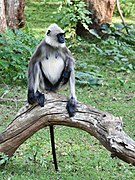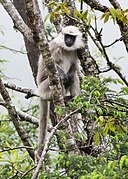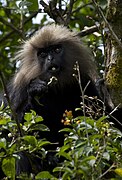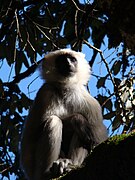| Semnopithecus | |
|---|---|

| |
| Gray langur in Mangaon, Maharashtra | |
| Scientific classification | |
| Domain: | Eukaryota |
| Kingdom: | Animalia |
| Phylum: | Chordata |
| Class: | Mammalia |
| Order: | Primates |
| Suborder: | Haplorhini |
| Infraorder: | Simiiformes |
| Family: | Cercopithecidae |
| Subfamily: | Colobinae |
| Tribe: | Presbytini |
| Genus: | Semnopithecus Desmarest, 1822 |
| Type species | |
| Simia entellus Dufresne, 1797 | |
| Species | |
|
S. schistaceus | |
Semnopithecus is a genus of Old World monkeys native to the Indian subcontinent, with all species with the exception of two being commonly known as gray langurs. Traditionally only the species Semnopithecus entellus was recognized, but since about 2001 additional species have been recognized. The taxonomy has been in flux, but currently eight species are recognized.
Members of the genus Semnopithecus are terrestrial, inhabiting forest, open lightly wooded habitats, and urban areas on the Indian subcontinent. Most species are found at low to moderate altitudes, but the Nepal gray langur and Kashmir gray langur occur up to 4,000 m (13,000 ft) in the Himalayas.
Characteristics
These langurs are largely gray (some more yellowish), with a black face and ears. Externally, the various species mainly differ in the darkness of the hands and feet, the overall color and the presence or absence of a crest. Typically all north Indian gray langurs have their tail tips looping towards their head during a casual walk whereas all south Indian and Sri Lankan gray langurs have an inverted "U" shape or a "S" tail carriage pattern. There are also significant variations in the size depending on the sex, with the male always larger than the female. The head-and-body length is from 51 to 79 cm (20 to 31 in). Their tails, at 69 to 102 cm (27 to 40 in) are always longer than their bodies. Langurs from the southern part of their range are smaller than those from the north. At 26.5 kg (58 lb), the heaviest langur ever recorded was a male Nepal gray langur. The larger gray langurs are rivals for the largest species of monkey found in Asia. The average weight of gray langurs is 18 kg (40 lb) in the males and 11 kg (24 lb) in the females.
Langurs mostly walk quadrupedally and spend half of their time on the ground and the other half in trees. They will also make bipedal hops, climbing and descending supports with the body upright, and leaps. Langurs can leap 3.6–4.7 m (12–15 ft) horizontally and 10.7–12.2 m (35–40 ft) in descending.
Taxonomy


Traditionally, only Semnopithecus entellus was recognized as a species, the remainder all being treated as subspecies. In 2001, it was proposed that seven species should be recognized. This was followed in Mammal Species of the World in 2005, though several of the seven species intergrade, and alternative treatments exist where only two species (a northern and a southern) are recognized. Phylogenetic evidence supports at least three species: a north Indian, a south Indian and a Sri Lankan one.
It has been suggested that the Semnopithecus priam thersites is worthy of treatment as a species rather than a subspecies, but at present this is based on limited evidence. During a study based on external morphology and ecological niche modelling in Peninsular India six main types were found, but continued to label all as subspecies. Coat color is highly variable, possible due to phenotypic plasticity and therefore of questionable value in species delimitation.
It has been suggested that Trachypithecus should be considered only a subgenus of Semnopithecus. If maintaining the two as separate monophyletic genera, the purple-faced langur and Nilgiri langur belong in Semnopithecus instead of their former genus Trachypithecus. At present it is unclear where the T. pileatus species group (consisting of the capped langur, Shortridge's langur and Gee's golden langur) belongs, as available mtDNA data place it in Semnopithecus, while Y chromosome data place it in Trachypithecus. A possible explanation for this is that the T. pileatus species group is the result of fairly recent hybridization between Semnopithecus and Trachypithecus.
As of 2005, the authors of Mammal Species of the World recognized the following seven Semnopithecus species
- Nepal gray langur Semnopithecus schistaceus
- Kashmir gray langur Semnopithecus ajax
- Tarai gray langur Semnopithecus hector
- Northern plains gray langur Semnopithecus entellus
- Black-footed gray langur Semnopithecus hypoleucos
- Southern plains gray langur Semnopithecus dussumieri
- Tufted gray langur Semnopithecus priam
Results of analysis of mitochondrial cytochrome b gene and two nuclear DNA-encoded genes of several colobine species revealed that Nilgiri and purple-faced langurs cluster with gray langur, while Trachypithecus species form a distinct clade. Since then, two other species have been moved from Trachypithecus to Semnopithecus:
- Purple-faced langur Semnopithecus vetulus
- Nilgiri langur Semnopithecus johnii
In addition, Semnopithecus dussumieri has been determined to be invalid. Most of the range that had been considered S. dussumieri is now considered S. entellus.
Thus the current generally accepted species within the genus Semnopithecus are:
| Common name | Scientific name and subspecies | Range | Size and ecology | IUCN status and estimated population |
|---|---|---|---|---|
| Black-footed gray langur | S. hypoleucos Blyth, 1841 Three subspecies
|
Southern India
|
Size: 41–78 cm (16–31 in) long, plus 69–108 cm (27–43 in) tail Habitat: Forest and shrubland Diet: Leaves, fruit, and flowers |
LC
|
| Kashmir gray langur
|
S. ajax (Pocock, 1928) |
Himalayas
|
Size: 41–78 cm (16–31 in) long, plus 69–108 cm (27–43 in) tail Habitat: Forest Diet: Leaves, bark, and seeds |
EN
|
| Nepal gray langur | S. schistaceus Hodgson, 1840 |
Himalayas
|
Size: 41–78 cm (16–31 in) long, plus 69–108 cm (27–43 in) tail Habitat: Forest, shrubland, and rocky areas Diet: Leaves and fruit, as well as seeds, roots, flowers, bark, twigs, coniferous cones, moss, lichens, ferns, shoots, rhizomes, grass, and invertebrate animals |
LC
|
| Nilgiri langur | S. johnii (J. Fischer, 1829) |

|
Size: 41–78 cm (16–31 in) long, plus 69–108 cm (27–43 in) tail Habitat: Forest Diet: Leaves, fruit, and flowers |
VU
|
| Northern plains gray langur | S. entellus (Dufresne, 1797) |
India
|
Size: 41–78 cm (16–31 in) long, plus 69–108 cm (27–43 in) tail Habitat: Forest, savanna, and shrubland Diet: Leaves, fruit, and flowers, as well as insects, bark, gum, and soil |
LC
|
| Tarai gray langur | S. hector (Pocock, 1928) |
Himalayas
|
Size: 41–78 cm (16–31 in) long, plus 69–108 cm (27–43 in) tail Habitat: Forest Diet: Leaves, fruit, and flowers |
NT
|
| Tufted gray langur | S. priam Blyth, 1844 Three subspecies
|
Southern India and Sri Lanka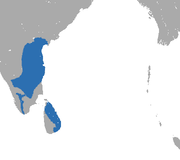
|
Size: 41–78 cm (16–31 in) long, plus 69–108 cm (27–43 in) tail Habitat: Forest and shrubland Diet: Leaves and fruit |
NT
|
| Purple-faced langur | S. vetulus (Erxleben, 1777) Four subspecies
|
Sri Lanka
|
Size: 41–78 cm (16–31 in) long, plus 69–108 cm (27–43 in) tail Habitat: Forest Diet: Leaves, fruit, flowers, and seeds |
EN
|
A 2013 genetic study indicated that while S. entellus, S. hypoleucos, S. priam and S. johnii are all valid taxa, there has been hybridization between S. priam and S. johnii. It also indicated that there has been some hybridization between S. entellus and S. hypoleucos where their ranges overlap, and a small amount of hybridization between S. hypoleucos and S. priam. It also suggested that S. priam and S. johnii diverged from each other fairly recently.
Distribution and habitat
The entire distribution of all gray langur species stretches from the Himalayas in the north to Sri Lanka in the south, and from Bangladesh in the east to Pakistan in the west. They possibly occur in Afghanistan. The bulk of the gray langur distribution is within India, and all seven currently recognized species have at least a part of their range in this country.
Gray langurs can adapt to a variety of habitats. They inhabit arid habitats like deserts, tropical habitats like tropical rainforests and temperate habitats like coniferous forests, deciduous habitats and mountains habitats. They are found at sea level to altitudes up to 4,000 m (13,000 ft). They can adapt well to human settlements, and are found in villages, towns and areas with housing or agriculture. They live in densely populated cities like Jodhpur, which has a population numbering up to a million.
Ecology and behavior

Gray langurs are diurnal. They sleep during the night in trees but also on man-made structures like towers and electric poles when in human settlements. When resting in trees, they generally prefer the highest branches.
Ungulates like bovine and deer will eat food dropped by foraging langurs. Langurs are preyed upon by leopards, dholes and tigers. Wolves, jackals, Asian black bears and pythons may also prey on langurs.
Diet

Gray langurs are primarily herbivores. However, unlike some other colobines they do not depend on leaves and leaf buds of herbs, but will also eat coniferous needles and cones, fruits and fruit buds, evergreen petioles, shoots and roots, seeds, grass, bamboo, fern rhizomes, mosses, and lichens. Leaves of trees and shrubs rank at the top of preferred food, followed by herbs and grasses. Non-plant material consumed include spider webs, termite mounds and insect larvae. They forage on agricultural crops and other human foods, and even accept handouts. Although they occasionally drink, langurs get most of their water from the moisture in their food.
Social structure

Gray langurs exist in three types of groups:
- one-male groups, comprising one adult male, several females and offspring;
- multiple-male groups, comprising males and females of all ages;
- all-male groups.
All-male groups tend to be the smallest of the groups and can consist of adults, subadults, and juveniles. Some populations have only multiple-male groups as mixed sex groups, while others have only one-male groups as mixed sexed groups.
Some evidence suggests multiple-male groups are temporary and exist only after a takeover, and subsequently split into one-male and all-male groups.
Social hierarchies exist for all group types. In all-male groups, dominance is attained through aggression and mating success. With sexually mature females, rank is based on physical condition and age. The younger the female, the higher the rank. Dominance rituals are most common among high-ranking langurs. Most changes in social rank in males take place during changes in group members. An adult male may remain in a one-male group for 45 months. The rate of male replacement can occur quickly or slowly depending on the group.
Females within a group are matrilineally related. Female memberships are also stable, but less so in larger groups. Relationships between the females tend to be friendly. They will do various activities with each together, such as foraging, traveling and resting. They will also groom each other regardless of their rank. However, higher-ranking females give out and receive grooming the most. In addition, females groom males more often than the other way around. Male and female relationships are usually positive. Relationships between males can range from peaceful to violent. While females remain in their natal groups, males will leave when they reach adulthood. Relationships between groups tend to be hostile. High-ranking males from different groups will display, vocalize, and fight among themselves.
Reproduction and parenting


In one-male groups, the resident male is usually the sole breeder of the females and sires all the young. In multiple-male groups, the highest-ranking male fathers most of the offspring, followed by the next-ranking males and even outside males will father young. Higher-ranking females are more reproductively successful than lower-ranking ones.
Female gray langurs do not make it obvious that they are in estrous. However, males are still somehow able to deduce the reproduction state of females. Females signal that they are ready to mate by shuddering the head, lowering the tail, and presenting their anogenital regions. Such solicitations do not always lead to copulation. When langurs mate, they are sometimes disrupted by other group members. Females have even been recorded mounting other females.
The gestation period of gray langur lasts around 200 days, at least at Jodhpur, India. In some areas, reproduction is year-around. Year-round reproduction appears to occur in populations that capitalize on human-made foods. Other populations have seasonal reproduction. Infanticide is common among gray langurs. Most infanticidal langurs are males that have recently immigrated to a group and driven out the prior male. These males only kill infants that are not their own. Infanticide is more commonly reported in one-male groups, perhaps because one male monopolizing matings drives the evolution of this trait. In multiple-male groups, the costs for infanticidal males are likely to be high as the other males may protect the infants and they can't ensure that they'll sire young with other males around. Nevertheless, infanticide does occur in these groups, and is suggested that such practices serve to return a female to estrous and gain the opportunity to mate.
Females usually give birth to a single infant, although twins do occur. Most births occur during the night. Infants are born with thin, dark brown or black hair and pale skin. Infants spend their first week attached to their mothers' chests and mostly just suckle or sleep. They do not move much in terms of locomotion for the first two weeks of their life. As they approach their sixth week of life, infants vocalize more. They use squeaks and shrieks to communicate stress. In the following months, the infants are capable of quadrupedal locomotion and can walk, run and jump by the second and third months. Alloparenting occurs among langurs, starting when the infants reach two years of age. The infant will be given to the other females of the group. However, if the mother dies, the infant usually follows. Langurs are weaned by 13 months.
Vocalizations
Gray langurs are recorded to make a number of vocalizations:
- loud calls or whoops made only by adult males during displays;
- harsh barks made by adult and subadult males when surprised by a predator;
- cough barks made by adults and subadults during group movements;
- grunt barks made mostly by adult males during group movements and agonistic interactions;
- rumble screams made in agonistic interactions;
- pant barks made with loud calls when groups are interacting;
- grunts made in many different situations, usually in agonistic ones;
- honks made by adult males when groups are interacting;
- rumbles made during approaches, embraces, and mounts;
- hiccups made by most members of a group when they find another group.
Status and conservation
Gray langurs have stable populations in some areas and declining ones in others. Both the black-footed gray langur and Kashmir gray langur are considered threatened. The latter is the rarest species of gray langur, with less than 250 mature individuals remaining.
In India, gray langurs number at around 300,000. India has laws prohibiting the capturing or killing of langurs, but they are still hunted in some parts of the country. Enforcement of these laws has proven to be difficult and it seems most people are unaware of their protection. Populations are also threatened by mining, forest fires and deforestation for wood.
Langurs can be found near roads and can become victims of automobile accidents. This happens even in protected areas, with deaths by automobile collisions making nearly a quarter of mortality in Kumbhalgarh Wildlife Sanctuary in Rajasthan, India. Langurs are considered sacred in the Hindu religion and are sometimes kept for religious purposes by Hindu priests and for roadside performances. However, some religious groups use langurs as food and medicine, and parts of gray langurs are sometimes kept as amulets for good luck.
Because of their sacred status and their less aggressive behavior compared to other primates, langurs are generally not considered pests in many parts of India. Despite this, research in some areas show high levels of support for the removal of langurs from villages, their sacred status no longer important. Langurs will raid crops and steal food from houses, and this causes people to persecute them. While people may feed them in temples, they do not extend such care to monkeys at their homes. Langurs stealing and biting people to get food in urban areas may also contribute to more persecutions.
References
- ^ Groves, C. P. (2005). "Genus Semnopithecus". In Wilson, D. E.; Reeder, D. M. (eds.). Mammal Species of the World: A Taxonomic and Geographic Reference (3rd ed.). Baltimore: Johns Hopkins University Press. pp. 174–175. ISBN 0-801-88221-4. OCLC 62265494.
- ^ Singh, M.; Kumara, H. N.; Long, Y.; Chetry, D.; Kumar, A. (2020). "Semnopithecus schistaceus". IUCN Red List of Threatened Species. 2020: e.T39840A17942792. doi:10.2305/IUCN.UK.2020-2.RLTS.T39840A17942792.en.
- ^ Kumar, A.; Singh, M.; Anandam, M.; Ahuja, V.; Kumara, H. N.; Molur, S. (2020). "Semnopithecus ajax". IUCN Red List of Threatened Species. 2020: e.T39833A17943210. doi:10.2305/IUCN.UK.2020-2.RLTS.T39833A17943210.en.
- ^ Groves, C. (2001). Primate taxonomy. Washington DC: Smithsonian Institution Press. ISBN 1-56098-872-X.
- ^ Brandon-Jones, D. (2004). "A taxonomic revision of the langurs and leaf monkeys (Primates: Colobinae) of South Asia" (PDF). Zoos' Print Journal. 19 (8): 1552–1594. doi:10.11609/jott.zpj.971.1552-94.
- Roonwal, M.L. (1981). "Intraspecific variation in size, proportion of body parts and weight in the hanuman langur, Presbytis entellus (Primates), in South Asia, with remarks on subspeciation" (PDF). Records of the Zoological Survey of India. 79 (1–2): 125–158. doi:10.26515/rzsi/v79/i1-2/1981/161760. S2CID 251696925.
- ^ Burnie D and Wilson DE (Eds.), Animal: The Definitive Visual Guide to the World's Wildlife. DK Adult (2005), ISBN 0-7894-7764-5
- Ripley S. (1967). "The leaping of langurs: a problem in the study of locomotor adaptation". American Journal of Physical Anthropology. 26 (2): 149–170. doi:10.1002/ajpa.1330260206.
- ^ Osterholz, M.; Walter, L.; Roos, C. (2008). "Phylogenetic position of the langur genera Semnopithecus and Trachypithecus among Asian colobines, and genus affiliations of their species groups". BMC Evolutionary Biology. 8: 58. doi:10.1186/1471-2148-8-58. PMC 2268674. PMID 18298809.
- ^ Karanth, P. (2010). "Molecular systematics and conservation of the langurs and leaf monkeys of South Asia". Journal of Genetics. 89 (4): 393–399. doi:10.1007/s12041-010-0057-3. PMID 21273689. S2CID 17712174. Retrieved 2019-02-08.
- Molur, S.; Singh, M.; Kumar, A. (2008). "Semnopithecus priam". IUCN Red List of Threatened Species. 2008: e.T135440A4128558.
- ^ Nag, C.; Karanth, P. (2011). "Taxonomic implications of a field study of morphotypes of hanuman langurs (Semnopithecus entellus) in Peninsular India" (PDF). International Journal of Primatology. 32 (4): 830–848. doi:10.1007/s10764-011-9504-0. S2CID 22233326.
- Nag, C.; Praveen, K. K.; Vasudeva, G. K. (2014). "Delineating ecological boundaries of hanuman langur species complex in Peninsular India using MaxEnt modeling approach". PLOS ONE. 9 (2): e87804. Bibcode:2014PLoSO...987804C. doi:10.1371/journal.pone.0087804. PMC 3912124. PMID 24498377.
- Karanth, K. P.; Singh, L.; Collura, R. V.; Stewart, C. B. (2008). "Molecular phylogeny and biogeography of langurs and leaf monkeys of South Asia (Primates: Colobinae)" (PDF). Molecular Phylogenetics and Evolution. 46 (2): 683–694. doi:10.1016/j.ympev.2007.11.026. PMID 18191589.
- ^ Wilson, Don E.; Mittermeier, Russell A.; Rylands, Anthony B. (2013). "Introduction". Handbook of the Mammals of the World, Volume 3: Primates (1st ed.). Lynx Edicions. ISBN 978-8496553897. Retrieved 2018-08-30.
- ^ Roos, C.; Boonratana, R.; Supriatna, J.; Fellowes, J. R.; Groves, C. P.; Nash, S. D.; Rylands, A. B.; Mittermeier, R. A. (2014). "An updated taxonomy and conservation status review of Asian primates" (PDF). Asian Primates Journal. 4 (1): 2–38.
- ^ "Semnopithecus". Mammal Diversity Database. Retrieved 2019-02-01.
- ^ "Semnopithecus". ITIS. Retrieved 2019-02-01.
- ^ Nowak 1999, p. 160
- ^ Singh, M.; Kumara, H. N.; Kumar, A.; Nag, C. (2020). "Semnopithecus hypoleucos". IUCN Red List of Threatened Species. 2020: e.T167543916A17942313. doi:10.2305/IUCN.UK.2020-2.RLTS.T167543916A17942313.en.
- ^ Singh, M.; Kumara, H. N.; Kumar, A. (2020). "Semnopithecus johnii". IUCN Red List of Threatened Species. 2020: e.T44694A17958623. doi:10.2305/IUCN.UK.2020-2.RLTS.T44694A17958623.en.
- ^ Kumara, H. N.; Kumar, A.; Singh, M. (2020). "Semnopithecus entellus". IUCN Red List of Threatened Species. 2020: e.T39832A17942050. doi:10.2305/IUCN.UK.2020-2.RLTS.T39832A17942050.en.
- Semke, Rebecca (2011). "Semnopithecus entellus". Animal Diversity Web. University of Michigan. Archived from the original on July 24, 2023. Retrieved July 24, 2023.
- ^ Singh, M.; Kumar, A.; Kumara, H. N.; Ahuja, V. (2020). "Semnopithecus hector". IUCN Red List of Threatened Species. 2020: e.T39837A17942651. doi:10.2305/IUCN.UK.2020-2.RLTS.T39837A17942651.en.
- ^ Singh, M.; Kumara, H. N.; Dittus, W.; Kumar, A.; Nag, C. (2020). "Semnopithecus priam". IUCN Red List of Threatened Species. 2020: e.T167546892A17942964. doi:10.2305/IUCN.UK.2020-2.RLTS.T167546892A17942964.en.
- ^ Rudran, R.; Dittus, W.; Gamage, S. N.; Nekaris, K. A. I. (2020). "Semnopithecus vetulus". IUCN Red List of Threatened Species. 2020: e.T22042A17959452. doi:10.2305/IUCN.UK.2020-2.RLTS.T22042A17959452.en.
- ^ Ashalakshmi, N.C.; Nag, K. S. C.; Karanth, K. P. (2014). "Molecules support morphology: species status of South Indian populations of the widely distributed Hanuman langur". Conservation Genetics. 16: 43–58. doi:10.1007/s10592-014-0638-4. S2CID 13993193.
- Roonwal, M.L., Mohnot, S.M. (1977) Primates of South Asia: ecology, sociobiology, and behavior. Harvard University Press, Cambridge (MA)
- Oppenheimer, J.R. (1977) "Presbytis entellus, the Hanuman langur". In: Rainier III (Grimaldi) Prince of Monaco, Bourne, G.H. (eds.) Primate conservation. New York: Academic Press ISBN 0-12-576150-3
- Bennett, E.L., Davies, A.G. (1994) "The ecology of Asian colobines". In: Davies, A.G., Oates, J.F. (eds.) Colobine monkeys: their ecology, behaviour and evolution. Cambridge University Press. pp. 129–171 ISBN 0-521-33153-6.
- Waite, T.A.; Chhangani, A.K.; Campbell, L.G.; Rajpurohit, L.S.; Mohonot, S.M. (2007). "Sanctuary in the city: urban monkeys buffered against catastrophic die-off during ENSO-related drought". EcoHealth. 4 (3): 278–286. doi:10.1007/s10393-007-0112-6. S2CID 23603380.
- Sharma SK (2002). "High-tension electric poles used as a night roost by troops of Hanuman langur Presbytes entellus at Nahargarh Wildlife Sanctuary, Jaipur". Journal of the Bombay Natural History Society. 99 (1): 103.
- Ramakrishnan U, Coss RG (2001). "A comparison of the sleeping behavior of three sympatric primates". Folia Primatology. 7 2 (1): 51–53. doi:10.1159/000049922. PMID 11275752. S2CID 349258.
- Punekar, S.A. (2002). "Some food plants of Hanuman langur Semnopithecus entellus (Dufresne) in the western Ghats of Maharashtra, India" (PDF). Zoos' Print Journal. 17 (6): 797–801. doi:10.11609/jott.zpj.17.6.797-801.
- Boggess, J. E. (1976). Social behavior of the Himalayan langur (Presbytis entellus) in eastern Nepal (PhD dissertation). University of California, Berkeley.
- Srivastava, A. (1991). "Insectivory and its significance to langur diets". Primates. 32 (2): 237–241. doi:10.1007/BF02381181. S2CID 32090680.
- Vogel, C. (1977) "Ecology and sociology of Presbytis entellus. In: Prasad, M.R.N., Anand Kumar, T.C. (eds.) Use of non-human primates in biomedical research. International Symposium held in New Delhi, India, November 1975. Indian National Science Academy, New Delhi. pp. 24–45.
- Starin, E.D. (1978). "A preliminary investigation of home range use in the Gir Forest langur". Primates. 19 (3): 551–568. doi:10.1007/BF02373316. S2CID 1067514.
- ^ Rajpurohit, L.S. (1992). "Origin and composition of the unisexual unit — an all-male band in Hanuman langur, Presbytis entellus, around Jodhpur, India". Prim Rep. 34: 47–52.
- ^ Newton P. (1994). "Social stability and change among forest Hanuman langurs (Presbytis entellus)". Primates. 35 (4): 489–498. doi:10.1007/BF02381957. S2CID 40545787.
- Mathur, R.; Manohar, B.R. (1990). "Density of Macaca mulatta and Presbytis entellus in the old city of Jaipur: a three year survey". Applied Animal Behaviour Science. 27 (4): 351–361. doi:10.1016/0168-1591(90)90130-6.
- Srivastava, A.; Mohnot, S.M. (1992). "Existence of multimale troops and their transformation into unimale troops in Hanuman langurs". Prim Rep. 34: 71–75.
- ^ Rajpurohit, D.S.; Rajpurohit, L.S. (2005). "Displacement interactions-the determinants of dominance hierarchy in Hanuman langur, Semnopithecus entellus around Jodhpur (India)". Journal Adv Zoology. 26 (2): 64–68.
- Rajpurohit, L.S.; Chhangani, A.K.; Rajpurohit, R.S.; Bhaker, N.R.; Rajpurohit, D.S.; Sharma, G. (2008). "Recent observation on resident male change followed by infanticide in Hanuman langurs (Semnopithecus entellus) around Jodhpur". Prim Rep. 75: 33–40.
- ^ Koenig, A. (2000). "Competitive regimes in forest-dwelling Hanuman langur females (Semnopithecus entellus)". Behav Ecol Sociobiology. 48 (2): 93–109. doi:10.1007/s002650000198. S2CID 22000806.
- ^ Borries, C.; Sommer, V.; Srivastava, A. (1991). "Dominance, age, and reproductive success in free-ranging female Hanuman langurs (Presbytis entellus)". Int J Primatol. 12 (3): 231–257. doi:10.1007/BF02547586. S2CID 19555929.
- ^ Newton, P.N. (1987). "The social organization of Hanuman langurs (Presbytis entellus)". International Journal of Primatology. 8 (3): 199–232. doi:10.1007/BF02735173. S2CID 10501648.
- Rajpurohit, L.S.; Chhangani, A.K.; Rajpurohit, R.S.; Mohnot, S.M. (2003). "Observation of a sudden resident-male replacement in a unimale bisexual troop of Hanuman langurs, Semnopithecus entellus, around Jodhpur (India)". Folia Primatol. 74 (2): 85–87. doi:10.1159/000070002. PMID 12778910. S2CID 46828619.
- Borries, C.; Sommer, V.; Srivastava, A. (1994). "Weaving a tight social net: allogrooming in a free-ranging female langurs (Presbytis entellus)". International Journal of Primatology. 15 (3): 421–443. doi:10.1007/BF02696102. S2CID 4718111.
- Ahsan, M.F.; Khan, M.A.R. (2006). "Eco-ethology of the common langur Semnopithecus entellus (Dufresne) in Bangladesh". University Journal of Zoology, Rajshahi University. 25: 3–10. doi:10.3329/ujzru.v25i0.317.
- Launhardt, K.; Borries, C.; Hardt, C.; Epplen, J.T.; Winkler, P. (2001). "Paternity analysis of alternative male reproductive routes among the langurs (Semnopithecus entellus) of Ramnagar". Animal Behaviour. 61 (1): 53–64. doi:10.1006/anbe.2000.1590. PMID 11170696. S2CID 29570442.
- Ostner, J.; Chalise, M.K.; Koenig, A.; Launhardt, K.; Nikolei, J.; Podzuweit, D.; Borries, C. (2006). "What hanuman langur males know about female reproductive status". American Journal of Primatology. 68 (7): 701–712. doi:10.1002/ajp.20260. PMID 16786522. S2CID 26498604.
- ^ Sommer, V.; Srivastava, A.; Borries, C. (1992). "Cycles, sexuality, and conception in free-ranging langurs (Presbytis entellus)". American Journal of Primatology. 28 (1): 1–27. doi:10.1002/ajp.1350280102. PMID 31941223. S2CID 85066777.
- Sommer, V., Schauer, P., Kyriazis, D. (2006) "A wild mixture of motivations: same-sex mounting in Indian langur monkeys". In: Sommer, V., Vasey, P.L. (eds.) Homosexual behaviour in animals: an evolutionary perspective. Cambridge University Press. pp. 238–372 ISBN 0-521-86446-1.
- Borries, C., Koenig A. (2000) "Infanticide in hanuman langurs: social organization, male migration, and weaning age". In: van Schaik, C.P., Janson, C.H. (eds.) Infanticide by males and its implications. Cambridge University Press. pp. 99–122 ISBN 0-521-77498-5.
- Borries, C. (1997). "Infanticide in Seasonally Breeding Multimale Groups of Hanuman Langurs" (Presbytis entellus) in Ramnagar". Behavioral Ecology and Sociobiology. 41 (3): 139–150. doi:10.1007/s002650050373. S2CID 37230153.
- Agoramoorthy, G. (1992). "Reproductive biology of the Hanuman langur Presbytis entellus in Jodhpur, western India". Journal of the Bombay Natural History Society. 89 (1): 84–93.
- ^ Sugiyama Y. (1965). "Behavioral development and social structure in two troops of Hanuman langurs (Presbytis entellus)". Primates. 6 (2): 213–247. doi:10.1007/BF01730967. S2CID 10784560.
- Dolhinow, P.; Murphy, G. (1982). "Langur monkey (Presbytis entellus) development: the first 3 months of life". Folia Primatologica. 39 (3–4): 305–331. doi:10.1159/000156082. PMID 7166290.
- Bhaker, N.R.; Rajpurohit, D.S.; Rajpurohit, LS. (2004). "Vocalization in Hanuman langur, Semnopithecus entellus around Jodhpur, Rajasthan". Uttar Pradesh Journal of Zoology. 24 (3): 227–233.
- Hohmann, G. (1989). "Comparative study of vocal communication in two Asian leaf monkeys, Presbytis johnii and Presbytis entellus". Folia Primatologica. 52 (1–2): 27–57. doi:10.1159/000156380. PMID 2807093.
- Srinivasulu C, Nagulu V (2001). "Status of primates in Andhra Pradesh". ENVIS Bulletin of Wildlife and Protected Areas. 1 (1): 109–112.
- Mukherjee RP (2001). "Status and conservation of non-human primates in India". ENVIS Bulletin of Wildlife and Protected Areas. 1 (1): 136–137.
- Choudhury A. (2001). "Primates in northeast India: an overview of their distribution and conservation status". ENVIS Bulletin of Wildlife and Protected Areas. 1 (1): 92–101.
- Rao RJ, Bhatnagar A (2001). "Primates of the Amarkantak forests, Madhya Pradesh". ENVIS Bulletin of Wildlife and Protected Areas. 1 (1): 120–123.
- Chhangani, A.K. (2004). "Killing of Hanuman langur (Semnopithecus entellus) in road accidents in Kumbhalgarh Wildlife Sanctuary, Rajasthan, India". Prim Rep. 69: 49–57.
- Ahmed A. (2001). "Illegal trade, and utilization of primates in India" (PDF). ENVIS Bulletin of Wildlife and Protected Areas. 1 (1): 177–184.
- ^ Chaudhuri S, Murmu A, Talukder B, Alfred JR (2004). "A population survey of Hanuman langurs in the district of Purulia, west Bengal". Rec Zool Surv India. 103 (3–4): 47–54. doi:10.26515/rzsi/v103/i3-4/2004/159337. S2CID 251714842.
- Manohar BR. (1999) "Jaipur monkeys-perspective of ecology and management". Sharma BD, editor. Indian wildlife resources ecology and development. Daya Pub House: Delhi. pp. 153–7 ISBN 81-7035-202-9.
- Pirta RS, Gadgil M, Kharshikar AV (1997). "Management of the rhesus monkey Macaca mulatta and Hanuman langur Presbytis entellus in Himachal Pradesh, India". Biol Conserv. 79 (1): 97–106. doi:10.1016/0006-3207(95)00131-X.
Sources
- Nowak, Ronald M. (1999). Walker's Primates of the World. Johns Hopkins University Press. ISBN 978-0-8018-6251-9.
External links
- Kurt Gron (28 October 2008). "Gray langur Semnopithecus". Primate Info Net. Retrieved 30 September 2010.
- Shah Jahan. "Save Earth Series – Hanuman Langur".
| Haplorhini | |||||||||||||||||||||||||||||||||||||||||||||
|---|---|---|---|---|---|---|---|---|---|---|---|---|---|---|---|---|---|---|---|---|---|---|---|---|---|---|---|---|---|---|---|---|---|---|---|---|---|---|---|---|---|---|---|---|---|
| |||||||||||||||||||||||||||||||||||||||||||||
| |||||||||||||||||||||||||||||||||||||||||||||
| |||||||||||||||||||||||||||||||||||||||||||||
| |||||||||||||||||||||||||||||||||||||||||||||
| Taxon identifiers | |
|---|---|
| Semnopithecus | |
